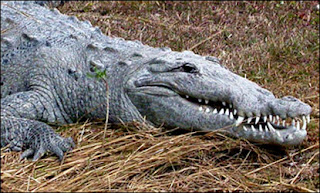Crocodiles and Alligators fall under the "threatened" category. They belong to a group of reptiles called crocodilians, which are the largest of the living reptiles. Of the 23 different species of crocodilians in the world, 2 species are native to the United States, and south Florida is the only place where both of these species coexist. The American alligator (Alligator mississippiensis) ranges throughout the southeastern United States, and Everglades alligators exist at the southern extreme of their range. American Crocodiles (Crocodylus acutus), on the other hand, inhabit coastal areas of south Florida where they are at the northern extreme of their range. American crocodiles also can be found on the islands of Cuba, Jamaica, and Hispaniola, as well as along both coasts of southern Mexico and Central America, south to Ecuador on the Pacific coast of South America, and Venezuela on the Atlantic coast.
At first glance crocodiles can be difficult to distinguish from alligators, but closer inspection reveals several important differences. The American crocodile is lizard-shaped with a long, muscular tail and four short legs that have five toes on the front feet and four on the back feet. Adults have grayish-green backs and tails and white to yellowish undersides. Their narrow snout is triangular in shape, and the fourth tooth on both sides of the lower jaw is visible when the mouth is closed. The ear drums are protected by moveable flaps of skin at the top of the head behind the eyes, and the nostrils are at the end of the elongated snout. Because of the location of the eyes, ears, and nostrils, a crocodile can be submerged with only the top of its head exposed and still be able to see, hear, and breathe. Male crocodiles are larger than females and can reach about 20 feet in length but rarely exceed 14 feet in the wild. Breeding females are about 8 to 12 feet in length.


Post a Comment